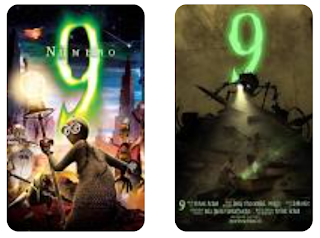Comparing 9, the short, and 9, the full-length movie
9 (2005), the short film:
Launching into a silent, post-apocalyptic world, 9 immediately captivates with its bleak beauty. Gritty textures meld with fantastical steampunk contraptions, while the scientist the protagonist, 9, navigates a desolate landscape with haunting grace. The plot, focused on survival and a desperate search for meaning, unfolds through evocative imagery and subtle gestures. While character development leans on archetypes (the lone hero, the monstrous pursuer), it's the visual storytelling that shines. Acker masterfully employs silence, relying on body language and expressive animation to convey emotion and tension. The ending, ambiguous yet hopeful, leaves a lasting impact.
9 (2009), the feature film:
Expanding the short's universe, the feature film injects color, dialogue, and a more elaborate narrative. We delve deeper into the world's lore and encounter a diverse cast of ragdolls, each with distinct personalities and motivations. While the special effects are stunning, particularly the intricate creature designs, the film occasionally loses the raw emotional power of the original. The plot feels stretched at times, relying on familiar genre tropes and sacrificing some of the short's enigmatic essence. However, the voice acting elevates the characters, and the expanded mythology adds fascinating context.
A Comparative Lens:
The short film triumphs in its minimalist brilliance. The tight focus on 9's journey, the haunting silence, and the evocative visuals create a deeply emotional experience. The open-ended nature allows for personal interpretation, leaving viewers pondering the themes of hope, loss, and resilience long after the credits roll. The feature film, on the other hand, excels in world-building and character development. It fleshes out the universe, offering a broader view of the struggle for survival and introducing nuanced relationships between the ragdolls. However, it loses some of the raw poetry and ambiguity that made the short so impactful.
Choosing a Favorite:
Ultimately, the choice between the two Nines comes down to personal preference. Do you favor the concentrated emotional punch of the short, or the expansive world and character interaction of the feature? For me, the original remains a masterpiece of visual storytelling, its stripped-down narrative and emotional resonance leaving a deeper mark. The feature film, while captivating in its own right, feels slightly diluted in comparison.
Convention Divergence:
Both films break convention in their own ways. The short defies genre boundaries, blending elements of post-apocalyptic fiction, steampunk, and fantasy into a unique cinematic experience. The feature film, while adhering to some genre conventions, subverts expectations by using ragdolls as protagonists and infusing the story with philosophical undertones about consciousness and the afterlife. Ultimately, Shane Acker's two Nines offer complementary experiences. The short stands as a testament to the power of minimalist storytelling, while the feature film expands the universe and explores its themes in greater depth. Whether you prefer the concentrated poetry of the short or the expansive world of the feature, both films showcase Acker's exceptional talent for creating visually stunning and emotionally resonant narratives.
Further Exploration:
This analysis merely scratches the surface of these captivating films. Diving deeper into specific scenes, analyzing the symbolism, and comparing the sound design could offer even richer insights. Additionally, exploring critical reception and fan interpretations would provide broader perspectives on their impact and significance. Ultimately, the Nines invite rewatching and analysis, rewarding attentive viewers with a deeper understanding of their complex themes and haunting beauty. I hope this comprehensive analysis proves valuable in your exploration of Shane Acker's work. Please let me know if you have any further questions or points you'd like me to delve deeper into. Remember, the magic of these films lies in their ability to spark individual interpretation and ignite lasting conversations.




Comments
Post a Comment